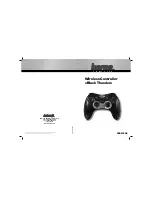
Temperature Controllers
E5CSZ
17
Precautions
!
CAUTION
Note: 1. A SELV circuit is one separated from the power supply with
double insulation or reinforced insulation, that does not
exceed 30 V r.m.s. and 42.4 V peak or 60 VDC.
2. A class 2 power supply is one tested and certified by UL as
having the current and voltage of the secondary output
restricted to specific levels.
■
Precautions for Safe Use
Be sure to observe the following precautions to prevent operation
failure, malfunction, or adverse affects on the performance and
functions of the product. Not doing so may occasionally result in
unexpected events.
1. The product is designed for indoor use only. Do not use the
product outdoors or in any of the following locations.
• Places directly subject to heat radiated from heating equipment.
• Places subject to splashing liquid or oil atmosphere.
• Places subject to direct sunlight.
• Places subject to dust or corrosive gas (in particular, sulfide gas
and ammonia gas).
• Places subject to intense temperature change.
• Places subject to icing and condensation.
• Places subject to vibration and large shocks.
2. Use and store the product within the rated temperature and
humidity ranges.
Group-mounting two or more Temperature Controllers, or
mounting Temperature Controllers above each other may cause
heat to build up inside the Temperature Controllers, which will
shorten their service life. In such a case, use forced cooling by
fans or other means of air ventilation to cool down the
Temperature Controllers.
3. To allow heat to escape, do not block the area around the product.
Do not block the ventilation holes on the product.
4. Use the specified size (M3.5, width of 7.2 mm or less) crimped
terminals for wiring. To connect bare wires to the terminal block,
use copper braided or solid wires with a gage of AWG24 to
AWG18 (equal to a cross-sectional area of 0.205 to 0.832 mm
2
).
(The stripping length is 5 to 6 mm.) Up to two wires of the same
size and type, or two crimp terminals can be inserted into a single
terminal.
5. Be sure to wire properly with correct polarity of terminals. Do not
wire any of the I/O terminals incorrectly.
6. Do not wire the terminals that are not used.
7. The voltage output (control output) is not electrically isolated from
the internal circuits. When using a grounded temperature sensor,
do not connect any of the control output terminals to ground.
Otherwise unwanted current paths will cause measurement
errors.
8. To avoid inductive noise, keep the wiring for the Temperature
Controller's terminal block away from power cables carrying high
voltages or large currents. Also, do not wire power lines together
with or parallel to Temperature Controller wiring. Using shielded
cables and using separate conduits or ducts is recommended.
Attach a surge suppressor or noise filter to peripheral devices that
generate noise (in particular, motors, transformers, solenoids,
magnetic coils or other equipment that have an inductance
component).
When a noise filter is used at the power supply, first check the
voltage or current, and attach the noise filter as close as possible
to the temperature controller.
Allow as much space as possible between the Temperature
Controller and devices that generate powerful high frequencies
(high-frequency welders, high-frequency sewing machines, etc.)
or surge.
Do not touch the terminals while power is being supplied.
Doing so may occasionally result in minor injury due to
electric shock.
Do not allow pieces of metal, wire clippings, or fine
metallic shavings or filings from installation to enter the
product. Doing so may occasionally result in electric
shock, fire, or malfunction.
Do not use the product where subject to flammable or
explosive gas. Otherwise, minor injury from explosion
may occasionally occur.
Never disassemble, modify, or repair the product or touch
any of the internal parts. Minor electric shock, fire, or
malfunction may occasionally occur.
CAUTION - Risk of Fire and Electric Shock
a) This product is UL listed as Open Type Process
Control Equipment. It must be mounted in an
enclosure that does not allow fire to escape externally.
b) More than one disconnect switch may be required to
de-energize the equipment before servicing the
product.
c) Signal inputs are SELV, limited energy. (See note 1.)
d) Caution: To reduce the risk of fire or electric shock, do
not interconnect the outputs of different Class
2 circuits. (See note 2.)
If the output relays are used past their life expectancy,
contact fusing or burning may occasionally occur. Always
consider the application conditions and use the output
relays within their rated load and electrical life
expectancy. The life expectancy of output relays varies
considerably with the output load and switching
conditions.
Loose screws may occasionally result in fire.
Tighten terminal screws to the specified torque of 0.74 to
0.90 N·m.
Unexpected operation may result in equipment damage
or accidents if the settings are not appropriate for the
controlled system. Set the Temperature Controller as
follows:
•
Set the parameters of the Temperature Controller so
that they are appropriate for the controlled system.
•
Turn the power supply to the Temperature Controller
OFF before changing any switch setting. Switch settings
are read only when the power supply is turned ON.
•
Make sure that the INIT switch in the control mode
switches is turned OFF before operating the
Temperature Controller.
A malfunction in the Temperature Controller may
occasionally make control operations impossible or
prevent alarm outputs, resulting in property damage.
To maintain safety in the event of malfunction of the
Temperature Controller, take appropriate safety
measures, such as installing a monitoring device on a
separate line.
Faulty terminal contact or decreased waterproofing
capability may result in a fire or equipment malfunction.
When inserting the Temperature Controller into the rear
case after setting the switches, check the watertight
packing and make sure that the top and bottom hooks are
locked securely in place.




































